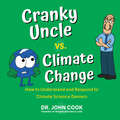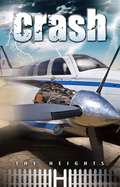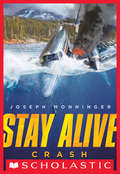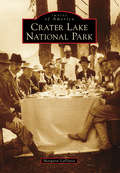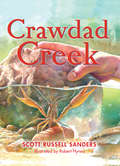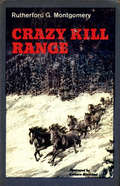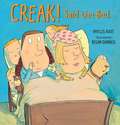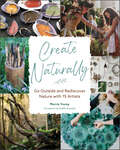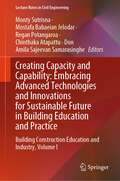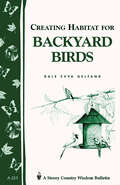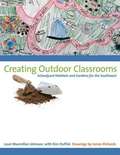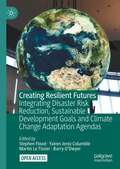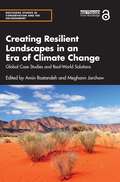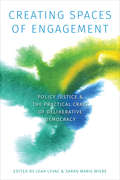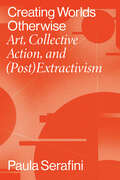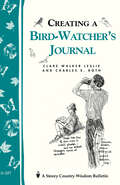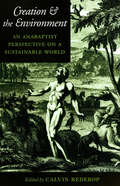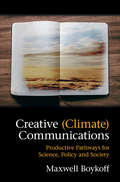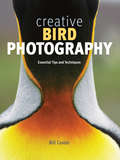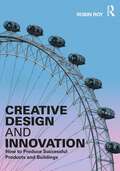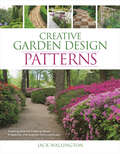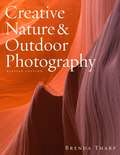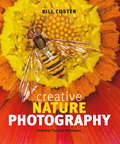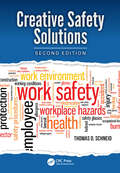- Table View
- List View
Cranky Uncle vs. Climate Change: How to Understand and Respond to Climate Science Deniers
by John CookIt&’s Not Just the Facts When it comes to climate change, this truly is a golden age—of fake news, post-truths, pluralistic ignorance, conspiracy theories, a willfully ignorant administration, and the Cranky Uncle. You know him. We all have one. That exasperating Thanksgiving blusterer digs in his heels even as the foundation of his denial thaws faster than the Arctic ice caps. Written and illustrated by Dr. John Cook, cognitive psychologist and founder of the award-winning website Skeptical Science, Cranky Uncle combines humor and science to make clear, calm, and winnable arguments in the public controversy of climate change. Can we change our Cranky Uncle&’s mind? Probably, regrettably, not. But Dr. Cook makes it easier for us to understand him. And armed with this knowledge, prevent climate misinformation from spreading further.
Crash (The Heights series)
by Ed Hansen Mary Kate DomanThese traditional reads are brimming with spirited characters and positive values--but with a little extra excitement and bite, so hold on to your hats! Written expressly for the middle grade struggling reader, the series does not contain strong language, edgy themes, or dysfunctional families. In fact, family is the main theme of these titles. And one particular Latino family is the focus with their uncanny knack for finding humor, hope, and colorful personalities--even in unusual circumstances. Written at the lowest reading levels, the 50-page story structure is straightforward and moves the reader through the text quickly and efficiently. Lightning lit the sky. The thunder was loud. The light went out. The plane went dark. Then the plane fell.
Crash: Crash (Stay Alive #1)
by Joseph MonningerStranded in the middle of nowhere, you have to fight to survive!When the members of Junior Action News Team crash land in the Alaskan backwoods, one thing is clear: not everyone is going to survive. No cell phones. No internet. Their supplies are limited, as is their knowledge of the wilderness. Part of the group wants to wait it out. Other wants to search for help. But above all they must stay alive!
Crater Lake National Park
by Margaret LaplanteFor more than half a million years, volcano Mount Mazama towered over southern Oregon. From time to time, it erupted, spreading pumice, ash, and cinders for miles around. Then, approximately 7,700 years ago, Mount Mazama erupted with such force that the volcano could no longer support itself and it collapsed, leaving a large caldera. Eventually, the volcanic action subsided and all was calm. Over the next centuries, water and snow accumulated in the caldera. In 1902, Crater Lake became a national park.
Crawdad Creek
by Scott Russell Sanders Robert HynesThere’s always something happening at Crawdad Creek. That’s what Lizzie and Michael call the stream that runs behind their house. Come pan for gold, hunt for fossils, find an arrowhead in the mud or a crayfish under a stone. Watch whirligig beetles and water striders skate across the water, teasing the fish below, and count the turtles sunning themselves on moss-covered logs. Follow tracks along the bank, then sit in quiet amazement as deer, raccoons, and other animals visit the creek. There’s a wild and beautiful world here waiting to be discovered. Take the time to look!
Crazy Kill Range
by Rutherford MontgomeryA black colt, born on a high plateau after his mother is stolen from a ranch, survives the dangers of life on the range to grow into a range stallion and leader of his own herd.
Creak! Said the Bed
by Phyllis RootIT'S THE MIDDLE OF THE NIGHT. Everyone is cozy and tucked up in bed when out of the darkness, SQUEAK, says the door. Mama's eyes fly open. Who's out of bed? Is it Evie? Ivy? Little Mo? On this stormy night in their little house, only Papa keeps snoring away -- Snurfle, Snark -- unaware of the wild weather outside and the growing number of nervous bedmates inside. Will anything wake Papa? CREAK, said the bed. A preposterous series of events takes readers barreling toward bedlam in this delicious read-aloud.
Create Naturally: Go Outside and Rediscover Nature with 15 Artists
by Marcia Young15 makers present personal stories of how nature inspires and enhances their creativityFor artists and crafters of all levels who look for inspiration in natureStories and projects help you find ways to connect to nature with your own works
Creating Capacity and Capability: Building Construction Education and Industry, Volume I (Lecture Notes in Civil Engineering #562)
by Regan Potangaroa Monty Sutrisna Mostafa Babaeian Jelodar Chinthaka Atapattu Don Amila Sajeevan SamarasingheThis three-volume book is the proceeding of the 46th Australasian Universities Building Education Association (AUBEA) 2023 Conference which brings together papers on construction and built environment education and practice. This particular conference theme, “Creating Capacity and Capability: Embracing Technologies and Innovations for Sustainable Future in Building Education and Practice” is closely related to a flagship national research programme funded by the Government of New Zealand, known as the CanConstructNZ research programme, aiming to balance the capacity and capability in the construction industry and the national pipeline of construction projects. The capacity and capability of our construction industry in fulfilling the construction needs of the whole nation are reflected in the national pipeline of construction projects and have long been recognised as one of the main challenges facing the construction sector. The practices and education of building and construction play an important role in determining the capacity and capability of the construction industry. Within the context of achieving sustainable future and embracing advanced technologies to create capacity and capability in the construction sector, various concepts, research, and innovative development have emerged and taken place. This particular conference theme has facilitated more in-depth discourses and discussions on the latest ideas and innovation within the building and construction education and practice, not only from the Australasian region but also from the wider international community, including the USA, the UK, Brazil, South Africa, Nigeria, China, and Sri Lanka. The contents of this book will be of interest to academic researchers, industry professionals and policy makers alike.
Creating Habitat for Backyard Birds: Storey's Country Wisdom Bulletin A-215 (Storey Country Wisdom Bulletin Ser.)
by Dale Evva GelfandSince 1973, Storey's Country Wisdom Bulletins have offered practical, hands-on instructions designed to help readers master dozens of country living skills quickly and easily. There are now more than 170 titles in this series, and their remarkable popularity reflects the common desire of country and city dwellers alike to cultivate personal independence in everyday life.
Creating Outdoor Classrooms
by Lauri Macmillan JohnsonSchoolyards have come a long way from the barren playgrounds that many people remember. Today's school campuses often feature gardens in which students can learn about native plants and wildlife, grow vegetables and fruit, explore cultural traditions, practice reading and math skills, and use their imaginations to create fun play spaces. And for a growing number of urban students, these schoolyard gardens offer the best, if not the only, opportunity to experience the natural world firsthand and enjoy its many benefits. This book is a practical, hands-on guide for creating a variety of learning environments in the arid Southwest. Filled with clear, easy-to-use information and illustrated with photographs, drawings, and plans, the book covers everything necessary to create schoolyard gardens:- An introduction to schoolyards as outdoor classrooms and several types of habitats, including art gardens, cultural history gardens, ecological gardens, literacy gardens, and vegetable gardens- Design theory, including a history of garden styles, and design principles and design elements- Beginning the design process, including identifying participants and writing a design program that sets out goals and requirements- Conducting site research and synthesizing design elements to arrive at a final design- Design essentials, including project funding and design features, maintenance, accessibility, safety, and project evaluation and revision- Wildlife ecology, including elements needed for survival such as food and shelter- Creating gardens for pollinators and other wildlife, including hummingbirds, butterflies, bees, moths, bats, and flies, as well as pest control- Lists of native plants for various kinds of habitats and nurseries that sell native plants, as well as books, web sites, and other resources for learning more about native plants and wildlifeThis guide will be essential for landscape architects, school personnel, parents, and students. Indeed, its principles can be used in designing schoolyard habitats across the country, while its information on gardening with native plants and wildlife will be useful to homeowners across the Southwest.
Creating Resilient Futures: Integrating Disaster Risk Reduction, Sustainable Development Goals and Climate Change Adaptation Agendas
by Stephen Flood Yairen Jerez Columbié Martin Le Tissier Barry O’DwyerThis open access edited volume critically examines a coherence building opportunity between Climate Change Adaptation, the Sustainable Development Goals and Disaster Risk Reduction agendas through presenting best practice approaches, and supporting Irish and international case studies. The Covid-19 pandemic has highlighted existing global inequalities and demonstrated the scope and scale of cascading socio-ecological impacts. The impacts of climate change on our global communities will likely dwarf the disruption brought on by the pandemic, and moreover, these impacts will be more diffuse and pervasive over a longer timeframe. This edited volume considers opportunities to address global challenges in the context of developing resilience as an integrated development continuum instead of through independent and siloed agendas.
Creating Resilient Landscapes in an Era of Climate Change: Global Case Studies and Real-World Solutions (Routledge Studies in Conservation and the Environment)
by Amin Rastandeh Meghann JarchowThis book delivers a realistic and feasible framework for creating resilient landscapes in an era of anthropogenic climate change. From across six continents, this book presents fifteen case studies of differing sociocultural, economic, and biophysical backgrounds that showcase opportunities and limitations for creating resilient landscapes throughout the world. The potential to create socio-ecological resilience is examined across a wide range of landscapes, including agricultural, island, forest, coastal, and urban landscapes, across sixteen countries: Argentina, Australia, Brazil, Denmark, Finland, Greece, Guatemala, Japan, Mexico, Norway, Samoa, South Africa, the United States, Turkey, Uruguay, and Vanuatu. Chapters discuss current and future issues around creating a sustainable food system, conserving biodiversity, and climate change adaptation and resilience, with green infrastructure, nature-based architecture, green-tech, and ecosystem services as just a few of the approaches discussed. The book emphasizes solution-oriented approaches for an "ecological hope" that can support landscape resiliency in this chaotic era, and the chapters consider the importance of envisioning an unpredictable future with numerous uncertainties. In this context, the key focus is on how we all can tackle the intertwined impacts of climate change, biodiversity loss, and large-scale land-cover conversion in urban and non-urban landscapes, with particular attention to the concept of landscape resiliency. The volume provides that much-needed link between theory and practice to deliver forward-thinking, practical solutions. This book will be of great interest to students, researchers, practitioners and policymakers who are interested in the complex relationship between landscapes, climate change, biodiversity loss, and land-based conversion at local, national and global scales.
Creating Spaces of Engagement: Policy Justice and the Practical Craft of Deliberative Democracy
by Sarah Marie Wiebe Leah R.E. LevacThere is a growing need for public buy-in if democratic processes are to run smoothly. But who exactly is "the public"? What does their engagement in policy-making processes look like? How can our understanding of "the public" be expanded to include – or be led by – diverse voices and experiences, particularly of those who have been historically marginalized? And what does this expansion mean not only for public policies and their development, but for how we teach policy? Drawing upon public engagement case studies, sites of inquiry, and vignettes, this volume raises and responds to these and other questions while advancing policy justice as a framework for public engagement and public policy. Stretching the boundaries of deliberative democracy in theory and practice, Creating Spaces of Engagement offers critical reflections on how diverse publics are engaged in policy processes.
Creating Successful Communities: A Guidebook To Growth Management Strategies
by Luther Propst Michael The Conservation Foundation Stephen F. Harper Michael MantellCreating Successful Communities is a practical compendium of techniques for effective land use and growth management. It offers a framework for land-use decisionmaking and growth management: techniques for protecting key resources such as agricultural land, open space, historic and cultural structure, aesthetics, and rivers and wetlands as well as ways to organize effectively. The companion Resource Guide provides detailed information on topics covered in I>Creating Successful Communities.
Creating Worlds Otherwise: Art, Collective Action, and (Post)Extractivism (Performing Latin American and Caribbean Identities)
by Paula SerafiniExtractivism has increasingly become the ground on which activists and scholars in Latin America frame the dynamics of ecological devastation, accumulation of wealth, and erosion of rights. These maladies are the direct consequences of longstanding extraction-oriented economies, and more recently from the expansion of the extractive frontier and the implementation of new technologies in the extraction of fossil fuels, mining, and agriculture. But the fields of sociology, political ecology, anthropology, and geography have largely ignored the role of art and cultural practices in studies of extractivism and post-extractivism. The field of art theory, on the other hand, has offered a number of texts that put forward insightful analyses of artwork addressing extraction, environmental devastation, and the climate crisis. However, an art theory perspective that does not engage firsthand and in depth with collective action remains limited and fails to provide an account of the role, processes, and politics of art in anti- and post-extractivist movements.Creating Worlds Otherwise examines the narratives that subaltern groups generate around extractivism, and how they develop, communicate, and mobilize these narratives through art and cultural practices. It reports on a two-year research project into creative resistance to extractivism in Argentina and builds on long-term engagement working on environmental justice projects and campaigns in Argentina and the UK. It is an innovative contribution to the fields of Latin American studies, political ecology, cultural studies, and art theory, and addresses pressing questions regarding what post-extractivist worlds might look like as well as how such visions are put into practice.
Creating a Bird-Watcher's Journal: Storey's Country Wisdom Bulletin A-207 (Storey Country Wisdom Bulletin Ser.)
by Clare Walker Leslie Charles E. RothSince 1973, Storey's Country Wisdom Bulletins have offered practical, hands-on instructions designed to help readers master dozens of country living skills quickly and easily. There are now more than 170 titles in this series, and their remarkable popularity reflects the common desire of country and city dwellers alike to cultivate personal independence in everyday life.
Creation and the Environment: An Anabaptist Perspective on a Sustainable World (Center Books in Anabaptist Studies)
by Calvin RedekopRecent years have seen a shift in the belief that a religious world-view, specifically a Christian one, precludes a commitment to environmentalism. Whether as "stewards of God's creation" or champions of "environmental justice," church members have increasingly found that a strong pro-ecology stand on environmental issues is an integral component of their faith. But not all Christian denominations are latecomers to the issue of environmentalism. In Creation and the EnvironmentCalvin W. Redekop and his co-authors explain the unique environmental position of the Anabaptists, in particular the Mennonites.After a brief survey of the major forces contributing to the word's present ecological crisis, Creation and the Environment explores the uniquely Anabaptist view of our relationship to what they see as the created order. In rural Amish and Mennonite communities, they explain, the environment—especially the "land"—is considered part of the Kingdom God plans to establish on earth. In this view, the creation is part of the divine order, with the redemption of humankind inextricably linked to the redemption and restoration of the material world. The well-being a purpose of creation and human history are thus seen as completely interdependent.Contributors: Donovan Ackley III, Claremont Graduate School • Kenton Brubaker, Eastern Mennonite University • Thomas Finger, Claremont Graduate School • Karen Klassen Harder, Bethel College, Kansas • James Harder, Bethel College, Kansas • Lawrence Hart, Cheyenne Cultural Center, Clinton, Oklahoma • Theodore Hiebert, McCormick Theological Seminary • Karl Keener, Pennsylvania State University • Walter Klaassen, Conrad Grebel College • David Kline, Holmes County, Ohio • Calvin W. Redekop, Conrad Grebel College • Mel Schmidt • Dorothy Jean Weaver, Eastern Mennonite University • Michael Yoder, Northwestern College, Iowa.
Creative (Climate) Communications: Productive Pathways for Science, Policy and Society
by Maxwell BoykoffConversations about climate change at the science-policy interface and in our lives have been stuck for some time. This handbook integrates lessons from the social sciences and humanities to more effectively make connections through issues, people, and things that everyday citizens care about. Readers will come away with an enhanced understanding that there is no 'silver bullet' to communications about climate change; instead, a 'silver buckshot' approach is needed, where strategies effectively reach different audiences in different contexts. This tactic can then significantly improve efforts that seek meaningful, substantive, and sustained responses to contemporary climate challenges. It can also help to effectively recapture a common or middle ground on climate change in the public arena. Readers will come away with ideas on how to harness creativity to better understand what kinds of communications work where, when, why, and under what conditions in the twenty-first century.
Creative Bird Photography
by Bill CosterThis beautifully illustrated, inspirational guide to bird photography is packed with practical advice for how to photograph birds presented in an informative but accessible writing style. Creative Bird Photography offers a fresh approach to its subject, looking closely at how to photograph specific aspects of birds' lives, such as eating and drinking, courtship, and flight. The author gives examples, demonstrating particular points and approaches for taking great shots of all of these daily bird activities as well as taking "mood" photographs at dawn and dusk. Each shot is accompanied by detailed technical data, information about locations, and advice about other challenges that will need to be surmounted in order to achieve the perfect shot. Coster also shares fascinating anecdotes about his encounters with the birds featured. There are also up-to-date sections on bird photography basics, including equipment and storage of digital images.
Creative Design and Innovation: How to Produce Successful Products and Buildings
by Robin RoyUsing many real-world examples and cases, this book identifies key factors and processes that have contributed to the creation of successful new products, buildings, and innovations, or resulted in some failures. Such factors include the creativity of individuals and groups, their sources of inspiration, the processes of creative design and innovation, and the characteristics of the products, buildings, and innovations themselves. Much has been written about creativity and innovation, but what helps to foster creativity, enable creative ideas to be translated into practical designs, and ensure those new products or buildings succeed as innovations on the market or in use? This book discusses these elements through the author’s origination and analysis of examples and case studies ranging from the revolutionary innovation of the smartphone, through radical innovations in domestic appliances and sustainable housing, to creative designs of contemporary jewellery. The broad range of examples and cases include product and fashion design, filmmaking and fine art, as well as industrial design, engineering, and architecture, offering lessons for creatives, designers, and innovators from many subject backgrounds. Analysis of the different factors, successes, and failures are presented in text boxes throughout the book to allow readers to easily understand the key lessons from each example or case, with numerous colour visuals, diagrams, and charts for illustration. This book is a must-read for a broad audience interested in creativity, design, and innovation, including practitioners in design, engineering, architecture, and product management, and students and instructors of those subjects.
Creative Garden Design: Inspiring Ideas for Creating Mood, Proportion, and Scale for Every Landscape
by Jack WallingtonCreative Garden Design: Patterns is a unique and practical reference for creating mood, proportion and scale in the garden. Its more than 500 photographs reveal the hidden patterns in plants, gardens and the wider landscape to inspire plans for gardens of all sizes and illustrate how to appreciate the styles of design in larger gardens andparks.Explore the influences of pattern in design and thepeople who made them and gain a greater understanding of the roles of color, texture, shape and perspective in the garden.Each chapter explores a different theme of garden pattern, including:• Plants with Pattern: Leaf Shape and Texture• Patterns within Layouts: Symmetrical and Formal• Patterns with Plants: Borders and Bedding• Patterns in Landscape: Paving and Walls• Water Patterns: Pools and StreamsAdditional features include profiles of patterns ingarden design history from abstract to Islamic gardens.A complete visual delight, Creative Garden Design:Patterns is a classic work that deserves pride of place on every garden designer&’s bookshelf.
Creative Nature & Outdoor Photography, Revised Edition
by Brenda TharpA classic guide to creative nature photography, now updated for the digital world.Amateur and experienced photographers interested in taking more compelling, personal images will love this new edition of Creative Nature & Outdoor Photography, now updated to address the exciting possibilities (and challenges) of digital image-making. Author Brenda Tharp's inspiring approach has garnered fans all over the world, as she teaches that magical skill no camera can do for you: learn how to "see." Readers expand their photographic vision and discover deep wellsprings of creativity as they learn to use light, balance, color, design, pattern, texture, composition, and many simple techniques to take a photo from ordinary to high-impact.Featuring more than 150 stunning, all-new images, Creative Nature & Outdoor Photography, Revised Edition is for anyone who understands the basic technical side to photography but wants to wake up their creative vision.From the Trade Paperback edition.
Creative Nature Photography
by Bill CosterAn indispensable guide to nature and outdoor photography, from the acclaimed author of Creative Bird Photography.This beautifully illustrated, inspirational guide to nature photography is packed with practical advice presented in author Bill Coster's informative but accessible writing style. It takes a fresh approach to the subject, breaking it up into chapters on habitats, each of which contains images of specific aspects of the environment, starting with landscapes and moving on to plants and animals. Each photograph demonstrates particular points and approaches, taking into account light conditions, terrain and the general surroundings. Fascinating anecdotes about Coster's experiences in each habitat bring the images to life. Each photograph is accompanied by detailed technical data, as well as information on locations and other issues that need to be tackled in order to achieve the perfect shot. There is also an up-to-date chapter on bird photography basics, including equipment such as cameras and lenses.
Creative Safety Solutions (Occupational Safety And Health Guide Ser. #18)
by Thomas D SchneidIn today's rapidly changing workplace, safety and loss prevention professionals cannot always "go by the book" for the answers to new and unique problems and issues. When there is no tried-and-true solution to a problem, safety and loss prevention professionals must think outside of the box of conventional solutions and develop new and creative sol
